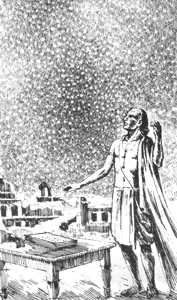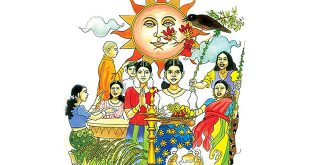 Aryabhata (476–550 CE) was the first in the line of great mathematician-astronomers from the classical age of Indian mathematics and Indian astronomy. His most famous works are the Aryabhatiya (499 CE, when he was 23 years old) and the Arya-siddhanta.
Aryabhata (476–550 CE) was the first in the line of great mathematician-astronomers from the classical age of Indian mathematics and Indian astronomy. His most famous works are the Aryabhatiya (499 CE, when he was 23 years old) and the Arya-siddhanta.
Nearly five hundred years after the birth of Christ a ritual was held near Khagola, the famous astronomical observatory at the University of Nalanda near Kusumapura (Patna), to mark the “birth” of a treatise that was to lay the foundation of a new school of thought in astronomy.
When the bell at the university tolled at 12 noon on March 21,499 A.D., a chorus of vedic chants filled the air. And priests, after prayers before a havan, led a 23-year-old astronomer to a platform. Silence prevailed as the astronomer sprinkled holy water on the parchment and pen lying on a desk placed on the platform. Chanting holy verses, he gazed at the sun overhead and prostrated himself in obeisance before sitting at the desk. Taking the pen, he wrote the first letter of the treatise while the priests chanted slokas and the large crowd of learned men showered flowers on him.
The young astronomer was Aryabhata and the treatise was Aryabhatiya. Born in 476 in Kerala, Aryabhata had come to complete his studies at the University of Nalanda, which was then a great centre of learning. When his treatise was recognized as a masterpiece, the then Gupta ruler Buddhagupta, made him head of the university.
Aryabhata was the first to deduce that the earth is round and that it rotates on its own axis, creating day and night. He declared that the moon is dark and shines only because of sunlight. Solar and lunar eclipses, he believed, occurred not because Rahu gobbled the sun and the moon, as Hindu mythology claimed, but because of the shadows cast by the earth and the moon.
He, however, believed in the geocentric concept of the universe that the earth is the center of the universe. To explain the “erratic” movements of some planets, he like the Greek king Ptolemy, made use of “epicycle”. But his method was superior to Ptolemy’s.
I n mathematics Aryabhata’s contributions are equally valuable. He gave the value of ? (pi) as 3.1416, claiming, for the first time, that it was an approximation. And he was the first mathematician to give what later came to be called the tables of Sines. His method to find a solution to indeterminate equations of the type ax – by = c is also recognized the world over. He also devised a novel method to express large numbers such as 100,000,000,000 in words. He developed this method to write unwieldy numbers in poetic form. The consise but somewhat difficult-to-grasp Aryabhatiya also dealt with other aspects of mathematics and astronomical calculations, namely, geometry, mensuration, square root, cube root, progression and celestial sphere.
n mathematics Aryabhata’s contributions are equally valuable. He gave the value of ? (pi) as 3.1416, claiming, for the first time, that it was an approximation. And he was the first mathematician to give what later came to be called the tables of Sines. His method to find a solution to indeterminate equations of the type ax – by = c is also recognized the world over. He also devised a novel method to express large numbers such as 100,000,000,000 in words. He developed this method to write unwieldy numbers in poetic form. The consise but somewhat difficult-to-grasp Aryabhatiya also dealt with other aspects of mathematics and astronomical calculations, namely, geometry, mensuration, square root, cube root, progression and celestial sphere.
In his old age Aryabhata also wrote another treatise, Aryabhatasiddhanta. It was a text-book for day-to-day astronomical calculations as well as a guide to determine auspicious times for various rituals. Even today Aryabhata’s astronomical data are used in preparing panchangs (Hindu calendars). It was in appreciation of his contributions to astronomy and mathematics that India’s first satellite was named Aryabhata.
 Kids Portal For Parents India Kids Network
Kids Portal For Parents India Kids Network






